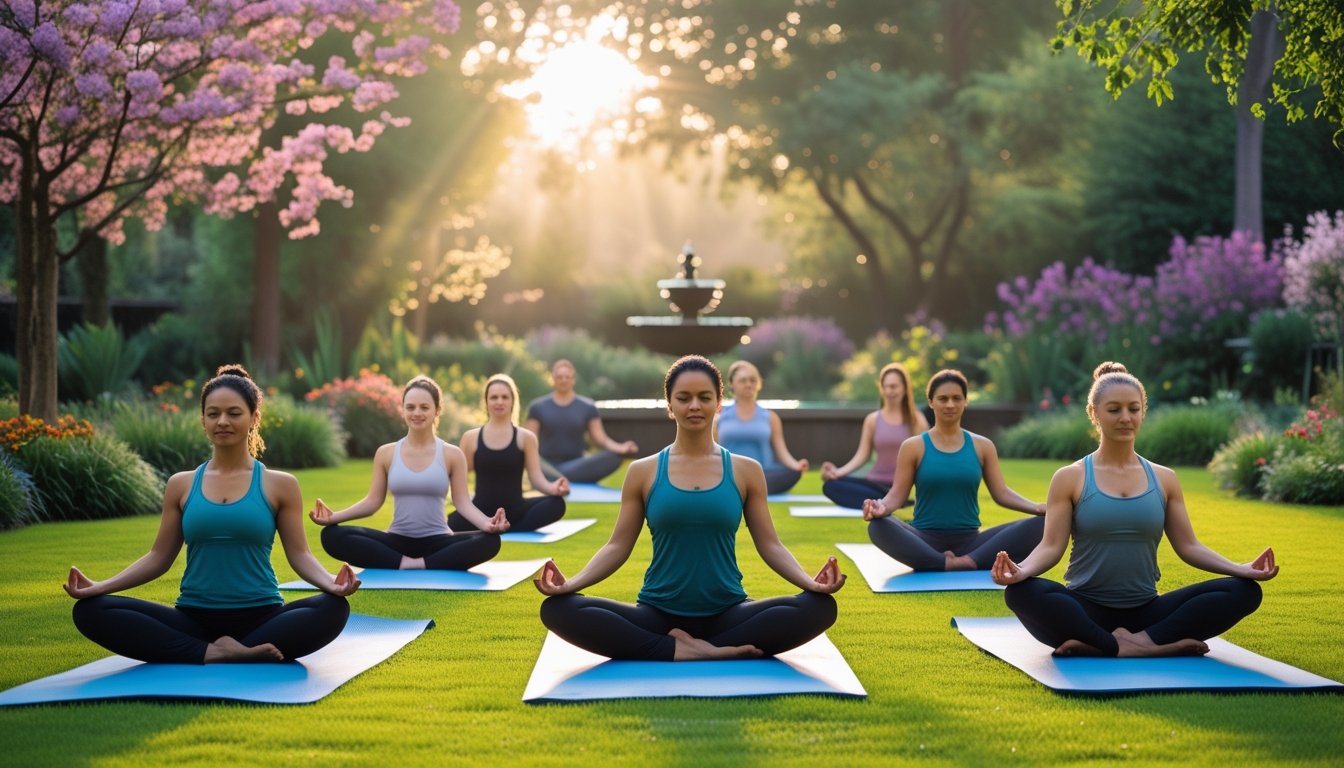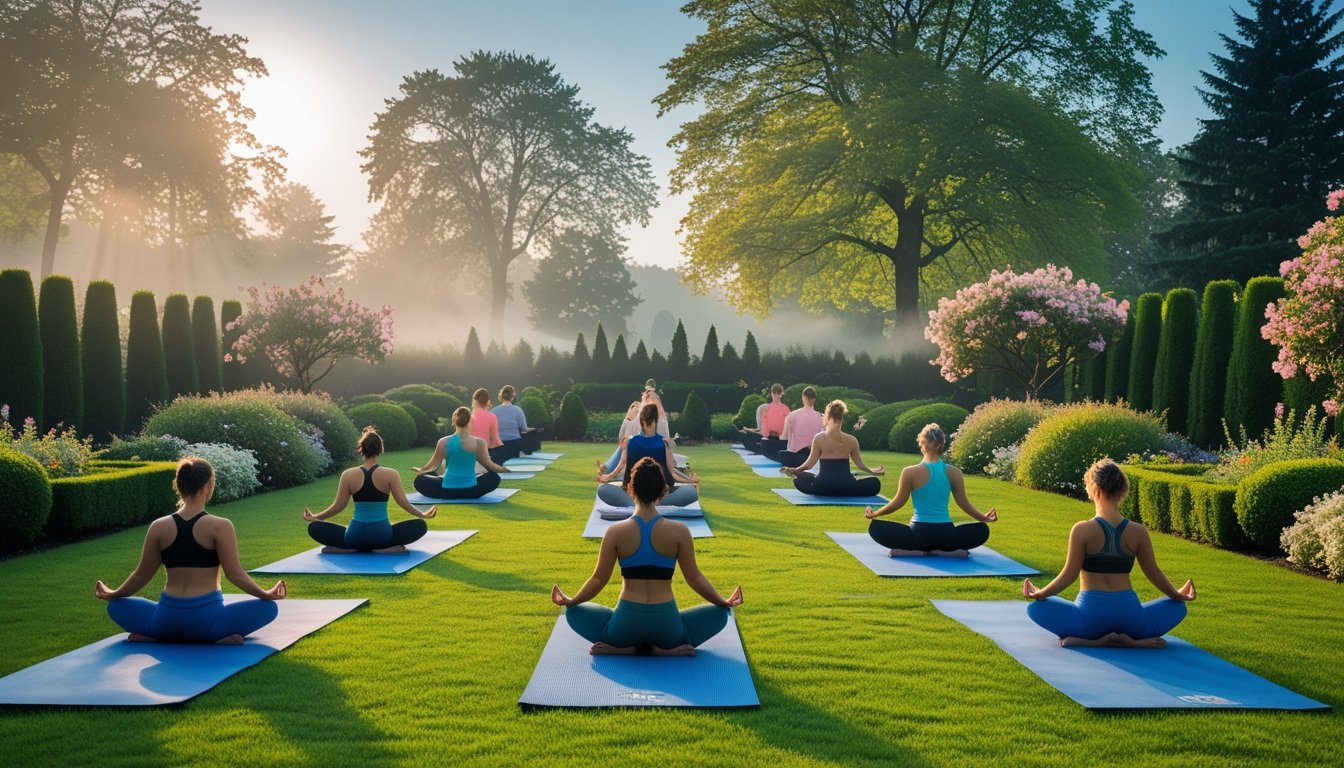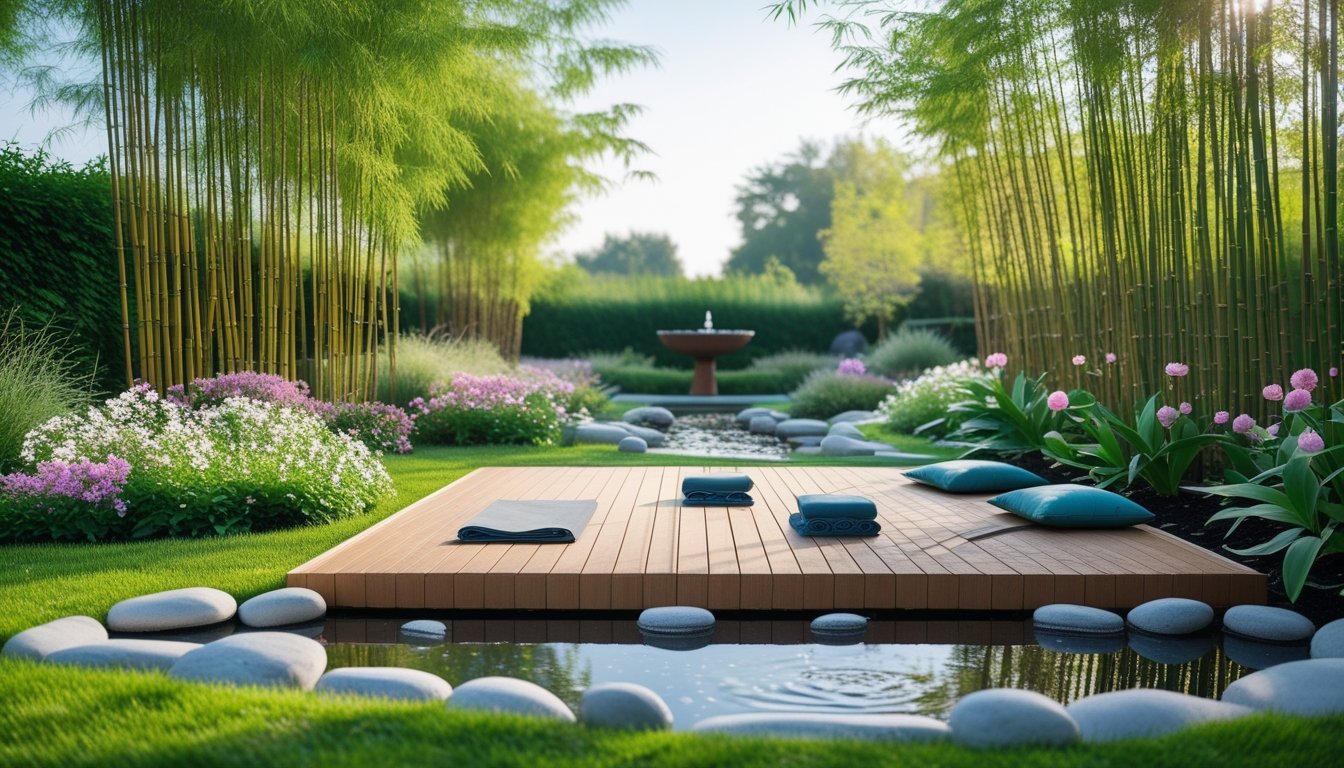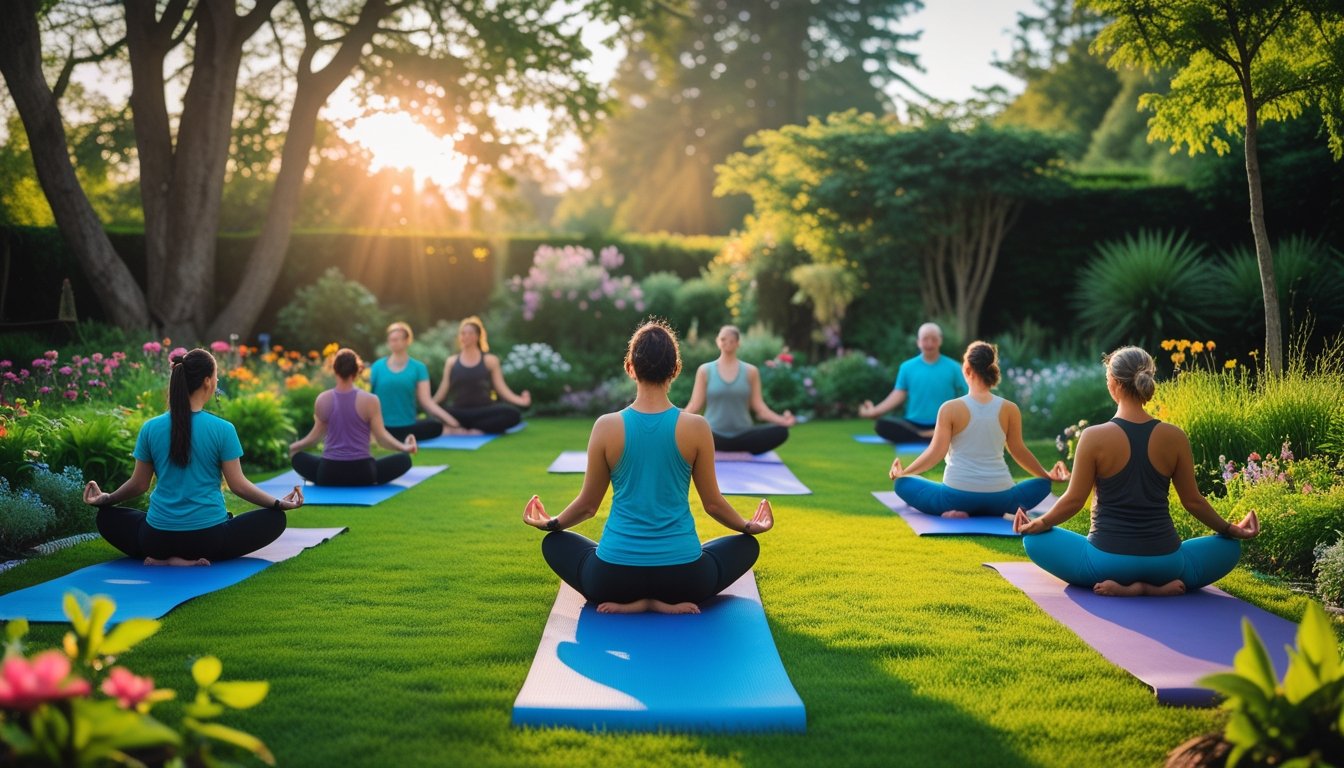Late updated: 18 Sep 2025 09:09
Written by: James Whitaker
Garden Yoga Practices For Tranquillity: Enhance Your Mindfulness Outdoors
Amidst the hustle and bustle of our daily lives, finding tranquillity can often seem like an elusive dream. Yet, the garden can transform into a serene sanctuary for those seeking peace through yoga. Practising yoga in a garden not only enhances our connection with nature but also fosters mental clarity and relaxation.

Our physical surroundings play a pivotal role in how we experience yoga. An outdoor setting infused with lush greenery or calming natural elements can significantly amplify the benefits of each pose. Creating a dedicated yoga garden embraces these ideas, transforming even the smallest space into an oasis of calm.
Imagine a yoga session where the gentle whisper of the wind and the soft rustle of leaves complement your breathwork and poses. By integrating mindful design principles, like water features and comfortable seating, we can craft spaces that inspire peace and tranquillity, enhancing the very essence of our practice.
Key Takeaways
- Garden yoga deepens our connection with nature.
- Thoughtful design creates an inspiring yoga space.
- Outdoor settings amplify yoga's benefits.
Core Principles of Garden Yoga Practices for Tranquillity

Our journey into the heart of garden yoga reveals key principles that enhance tranquillity. Embracing mindful movement, crafting a serene atmosphere, incorporating mindfulness and meditation, and identifying essential elements are the cornerstone of this pursuit.
Mindful Movement and Outdoor Practice
We focus on mindful movement, embarking on our yoga practice with attention to each breath and motion. Outdoor settings amplify this by connecting us more intimately with the natural surroundings.
Doing yoga in a garden allows us to engage all our senses, from the gentle rustling of leaves to the earthy scent of the soil. The practice encourages us to be present, moving through poses gracefully and with purpose. This immersion in nature promotes harmony between the external environment and our internal state, fostering a sense of peace and unity.
Creating a Tranquil Atmosphere
Crafting a tranquil atmosphere is pivotal in our quest for a serene yoga experience. The choice of location within the garden significantly impacts the overall tranquillity. We choose spaces that are shielded from noise and other distractions, ensuring that natural sounds prevail.
The use of water features such as fountains or small ponds can enhance this serene atmosphere, providing a soothing auditory backdrop. Strategic planting, with a mix of fragrant flowers and tall grasses, can create a visually calming and private space. These efforts culminate in a harmonious environment conducive to relaxation and mindfulness.
The Role of Mindfulness and Meditation
Mindfulness and meditation are central to our garden yoga practice, serving as anchors that ground us during each session. We practise focusing our attention on the present moment, allowing extraneous thoughts to drift away like clouds.
Meditation spots within our garden can be set up using simple seating or a dedicated corner where we can retreat to centre ourselves. By incorporating regular meditation, we enhance our practise, cultivating a deeper connection between body and mind. This practice facilitates a tranquil mental space that complements our physical surroundings.
Essential Elements for a Serene Outdoor Space
To create a serene outdoor space, several essential elements need attention. We focus on ensuring that the area is accessible and inviting, with clear pathways leading to our yoga spot.
Lighting plays a crucial role; soft, ambient lighting like solar-powered lanterns or string lights ensures usability during the evening while maintaining tranquillity. Choosing eco-friendly and weather-resistant materials for mats or seating areas helps integrate our yoga space into the environment. We also emphasise maintenance, regularly tending to the garden to ensure it remains an inviting and peaceful sanctuary.
Designing an Inspiring Yoga Garden for Ultimate Calm

Creating a garden designed specifically for yoga involves careful consideration of location, natural elements, and features that promote relaxation. By integrating these aspects thoughtfully, we can craft a serene space that significantly enhances our practice.
Selecting the Ideal Location and Layout
Finding the right spot for our yoga garden is essential. We should prioritise areas that offer privacy, perhaps using bamboo privacy screens or tall trees to shield our space from prying eyes. The location should capture natural light but provide enough shade to stay cool during summer practices.
In terms of layout, incorporating stone paths can guide us to different parts of the garden. A smooth wooden platform or a wooden deck serves as an excellent yoga practice area, providing a stable surface for our yoga mats. For inviting walking spaces, consider materials such as pebble or paver stones.
Integrating Natural Elements and Lush Greenery
Plants are vital for creating a calming atmosphere. We should aim to include a mix of native plants that require minimal maintenance, alongside tropical plants for a touch of exotic flair. Ferns, herbs, and aromatic plants such as rosemary and creeping thyme add both beauty and fragrance.
Integrating a vertical garden can save space while adding a lush backdrop, and ornamental grasses bring movement with every breeze. If space permits, a japanese maple or bonsai tree becomes a focal point, offering both visual and spiritual calmness to our garden.
Incorporating Water Features and Natural Sounds
Adding a water feature like a water fountain contributes to a serene environment by introducing soothing sounds of running water. Whether it's a small tabletop fountain or a larger garden installation, these features help drown out background noise.
Natural sounds are as important as visual elements. We can enhance auditory tranquillity by planting trees that rustle gently in the wind. Tall trees not only provide shade but also serve as a natural wind barrier, allowing us to connect deeply with the environment during our practice.
Choosing Comfortable Seating and Platforms
When considering seating, it's vital to prioritise comfort and functionality. A comfortable seating area with ergonomic chairs or benches made from weather-resistant materials can offer a place for meditation. Incorporating herb garden borders around these areas adds sensory delight.
For the yoga practice itself, a wooden platform or yoga deck ensures a level surface that's gentle on the joints, while a mix of colourful flowers nearby enhances the overall aesthetic and energy of the space. Our seating and platforms should encourage us to spend time in contemplation and mindfulness.
Frequently Asked Questions

Exploring yoga in a garden context allows us to meld the calming influence of nature with the restorative power of yoga. From adapting to seasonal changes to selecting the perfect time of day, understanding these elements can transform your practice into a tranquil retreat.
What are the best yoga poses to enhance relaxation in a garden setting?
In a garden setting, poses like Child’s Pose and Savasana are ideal for encouraging relaxation. These poses allow us to connect with the natural environment, enhancing focus and mindfulness. Additionally, practising the Tree Pose amongst trees can amplify our sense of balance and grounding.
How can incorporating nature into my yoga routine improve mental tranquillity?
Incorporating nature, such as listening to birdsong or feeling the grass beneath us, can significantly enhance mental tranquillity. Nature has a calming effect, reducing stress and promoting a deeper sense of peace. This connection helps us focus our practice, making it more holistic and fulfilling.
Which time of day is optimal for practising yoga outdoors to achieve a state of calm?
The early morning and late afternoon are prime times for outdoor yoga. The gentle light and cooler temperatures create a calm atmosphere. The stillness of the early hours or the softening light at sunset enhances our focus and mental relaxation during the practice.
What equipment should I consider for a comfortable and effective garden yoga session?
For a comfortable garden yoga session, we recommend a durable yoga mat suitable for outdoor surfaces, a blanket for added comfort, and any needed props like blocks or straps. Consider using a blanket for extra cushioning, especially when practising on uneven or hard surfaces.
How can I adapt my yoga practice to suit the changing seasons when outdoors?
Seasonal changes offer unique opportunities to adapt our practice. In warmer months, lighter clothing and hydration become essential. During colder periods, layering clothes to retain warmth and using thicker mats for insulation can make outdoor practice more comfortable and enjoyable.
Can garden yoga help in reducing stress, and what techniques are most effective?
Garden yoga is indeed beneficial for reducing stress. Incorporating breathwork and meditation into our practice allows us to harness the healing power of nature. Techniques like mindful breathing or focusing on natural sounds help in centring the mind and alleviating stress.
